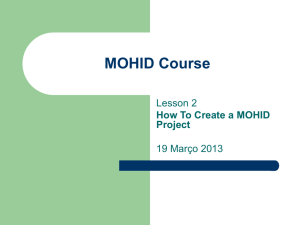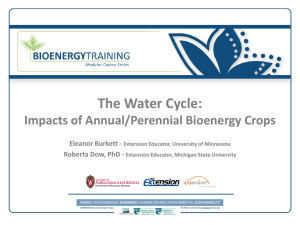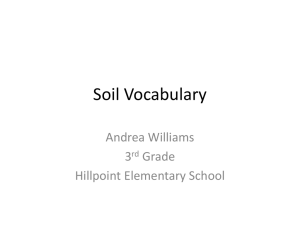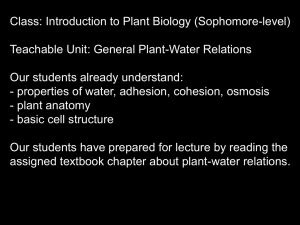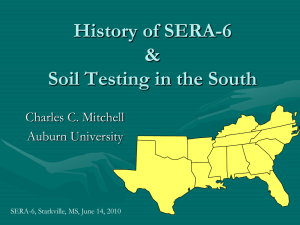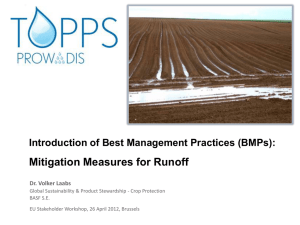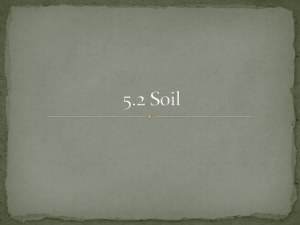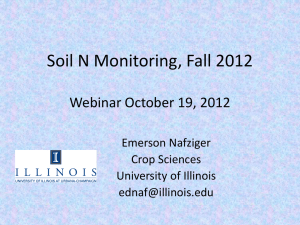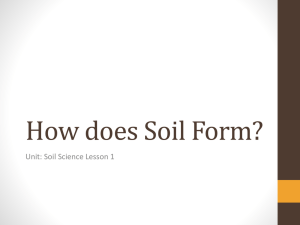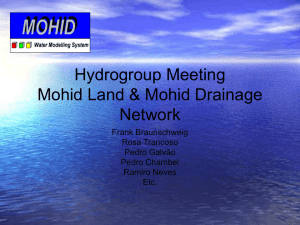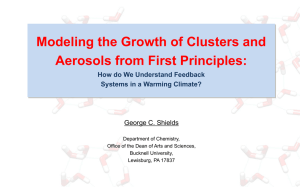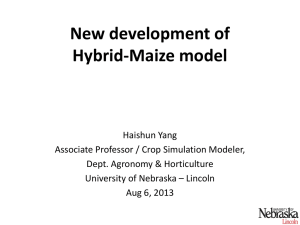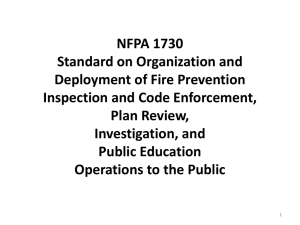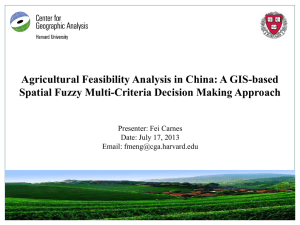Modelos de bacia
advertisement
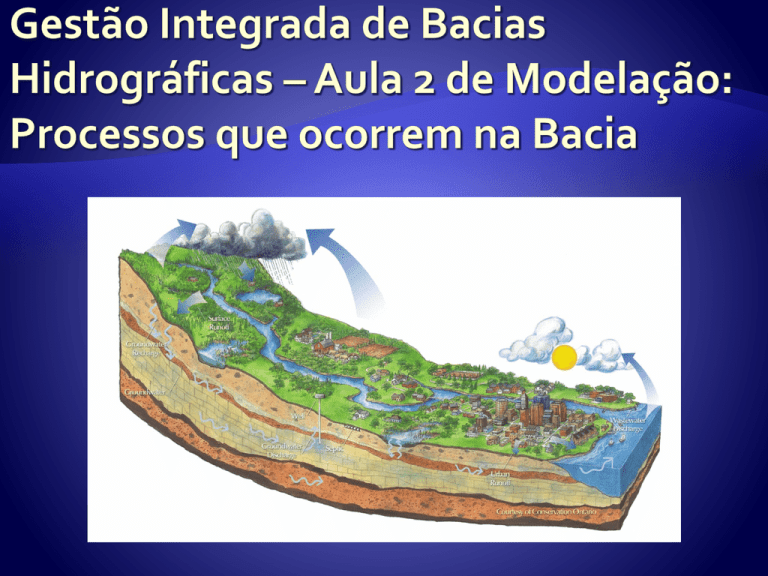
Wseep Ea Must be measured in rain gauges. In how many? How to interpolated/extrapolated? Inverse of the Distance Weight Regression Model THIESSEN POLYGON Depends on: Atmospheric conditions (HR, Temperature, radiation & wind) Available soil water (above wilting point) Transpiration surface (Leaf Area Index – LAI) Depends on plants Development and soil cover. http://www.fao.org/docrep/X0490E/x0490e06.htm Rn is the net radiation, G is the soil heat flux, (es - ea) ris the vapour pressure deficit of the air, r a is the mean air density at constant pressure, cp is the specific heat of the air, D is the slope of the saturation vapour pressure temperature relationship, g is the psychrometric constant, and rs and ra are the (bulk) surface and aerodynamic resistances. Richards Equation http://www.mohid.com/wiki/index.php?title=Module_PorousMedia#Water_retenti on 10cm 30cm 50cm 1 m 70cm 2 m Tempo T oalha F reática P-V Primavera-Verão ETR P-V P-V P-V Chuva 1º ANO 2º ANO 3º ANO Outono-Inverno O-I Rega 50cm O-I O-I O-I 35cm 15cm MOHID Land Watershed Water Content Runoff Rain Intensity IST – MARETEC 2008 Is the Rain that does not infiltrate. Flows at soil surface, can infiltrate (and sometimes exfiltrate. Flow is controlled by friction. Hydrology Vegetation (evapotranspiration, nutrients, pesticides, erosion,….) Mineralisation of Organic matter in the soil (bacterial loop) Irrigation Salts dynamics/chemical equilibrium Rivers, Reservoirs/lakes, Estuaries and Coastal Lagoons. All models compute Evapo-transpiration on the same way. Differences on results depend on the detail of the input data. Process oriented models (e.g. Hydrus, Mohid, Mike, RZWQM) compute percolation using the Richards Equation. They need fine grids. Other models use coarse grids and empirical formulations to compute flow (e.g. SWAT, HSPF, BASINS). Meteorological data processor, Climate (seasonal/daily solar evolution), GIS, Chemical Equilibrium, Plants Optimal Growth, Management Practices, Graphical interfaces. Production of plants is the major role of catchments. Diffuse pollution is mostly due to plant growth improvement: Fertilisation, Phyto-sanitation, irrigation. http://www.fao.org/docrep/009/a0100e/a0100e05.htm N2 CO2 NH4+ CH4 ANAEROBIC BIOMASS LABILE OM Psol REFRACTORY OM NO3 - AEROBIC BIOMASS CO2 AUTOTROPHIC BIOMASS NH4+ Urea NH3 Psol Pfix http://www.mohid.com/wiki/ http://en.wikipedia.org/wiki/MOHID_Land Distributed vs partially distribuited models MOHID Land SWAT 1D Drainage network Q t 2 2 2 H Q Q n 2 4/3 0 gA x A A Rh x 2D Overland flow 2/3 Q A. R h H / x n HRU 3D Porous Media t h z K (h) xi xi Watershed picture to farm plots; Vegetation and Erosion Flush events Precipitation Variable in Time & Space CN, Lag time Processos de qualidade da água em Rios CO2 O2 Nitrato Respiração Amónia Nutrientes Consumo Ortofosfato Sílica Bactérias Produtores Primários Excreção Consumo Morte Detritos / MO Deposição Sedimentos Produtores Secundários Kinematic wave equation (equilibrium between gravity and friction) Trapezoidal shape for channels in both models •Rch is the hydraulic radius for a given depth of flow (m), •slpch is the slope along the channel length (m/m), •n is Manning’s “n” coefficient in channel •vc is the flow velocity (m/s). If inertia is important: 2 2 2 H Q Q n 2 4/3 0 gA t x A A Rh x Q MOHID Land Watershed Water Content Runoff Rain Intensity IST – MARETEC 2008 MOHID Land River Sediment Rain Intensity WQ models in river IST – MARETEC 2008 wperc,ly is the amount of water percolating to the underlying soil layer on a given day (mm H2O), SWly,excess is the drainable volume of water in the soil layeron a given day (mm H2O), Δt is the length of the time step (hrs), TTperc is the travel time for percolation (hrs). SATly is the amount of water in the soil layer when completely saturated (mm H2O), FCly is the water content of the soil layer at field capacity (mm H2O), Ksat is the saturated hydraulic conductivity for the layer (mm·h-1). Qgw,i is the groundwater flow into the main channel on day i (mm H2O), Qgw,i-1 is the groundwater flow into the main channel on day i-1 (mm H2O), αgw isthe baseflow recession constant, Δt is the time step (1 day), and wrchrg is theamount of recharge entering the aquifer on day i (mm H2O). CN – Curve Number (0% -100% runoff) O CN is a function of: i) permeability, ii) land use and iii) previous soil water content. CN can change between 0.0 (no runoff) and 100 (all precipitation transformed into runoff). A High infiltration rates. B Moderate infiltration rates. C Low infiltration rates. D Very low infiltration rates. S – Soil water retention parameter (mm H2O) 1000 S 25 , 4 10 CN Q surf R R 0,2 S 2 day day 0 ,8 S Knowing Qsurf (acumulated runoff) it is possible to estimate infiltration IST- MARETEC 2009 1. Com base na topografia foram geradas 700 sub-bacias para a RH6 com áreas entre 0.001 km2 e 100 km2 2. 1 Sub-bacias foram geradas em função das massas de água Precipitação Precipitation 1 IST- MARETEC 2009 Flow 1. Cada sub-bacia comporta-se como uma Unidade de Resposta Hidrológica (HRU) com o mesmo uso de solo, tipo de solo e declive 1 RH6 Tipologia A2 Estuário mesotidal homogéneo com descargas irregulares de rio • Estuário do Sado 6 massas de água • Estuário do Mira 3 massas de água 8 IST- MARETEC 2009 28 IST- MARETEC 2009 Poucos dados - estações da Sado WB1 Poucos dados - estações da Sado WB2 Poucos dados - estações da Sado WB2 (individualmente e com a média das estações) Canal de Alcácer IST- MARETEC 2009

